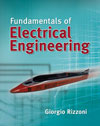
|  |
Book Preface| The pervasive presence of electronic devices and instrumentation in all aspects of engineering design and analysis is one of the manifestations of the electronic revolution that has characterized the second half of the 20th century. Every aspect of engineering practice, and even of everyday life, has been affected in some way or another by electrical and electronic devices and instruments. Computers are perhaps the most obvious manifestations of this presence. However, many other areas of electrical engineering are also important to the
practicing engineer, from mechanical and industrial engineering, to chemical, nuclear, and materials engineering, to the aerospace and astronautical disciplines, to civil and the emerging field of biomedical engineering. Engineers today must be able to communicate effectively within the interdisciplinary teams in which they work.OBJECTIVES
Engineering education and engineering professional practice have seen some rather profound changes in the past decade. The integration of electronics and computer technologies in all engineering academic disciplines and the emergence of digital electronics and microcomputers as a central element of many engineering products and processes have become a common theme since the conception of this book.
The principal objective of the book is to present the principles of electrical, electronic, and electromechanical engineering to an audience composed of non–electrical engineering majors, and ranging from sophomore students in their first required introductory electrical engineering course, to seniors, to first-year graduate students enrolled in more specialized courses in electronics, electromechanics, and mechatronics.
A second objective is to present these principles by focusing on the important results and applications and presenting the students with the most appropriate analytical and computational tools to solve a variety of practical problems.
Finally, a third objective of the book is to illustrate, by way of concrete, fully worked examples, a number of relevant applications of electrical engineering principles. These examples are drawn from the author’s industrial research experience and from ideas contributed by practicing engineers and industrial partners.ORGANIZATION AND CONTENT
The book is divided into three parts, devoted to circuits, electronics, and electromechanics.Part I: Circuits
The first part of this book presents a basic introduction to circuit analysis (Chapters 2 through 7). The material includes over 440 homework problems.Part: II Electronics
Part II, on electronics (Chapters 8 through 12), contains a chapter on operational amplifiers, one on diodes, two chapters on transistors—one each on BJTs and FETs, and one on digital logic circuits. The material contained in this section is focused on basic applications of these concepts. The chapters include 320 homework problems.Part III: Electromechanics
Part III, on electromechanics (Chapters 13 and 14), includes basic material on electromechanical transducers and the basic operation of DC and AC machines. The two chapters include 126 homework problems. |
|
|